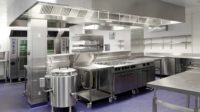Project Delivery Method: Design-Build (D-B)
Owner Team: Private school president, facility manager, owner representative (consultant), and food service manager (in-house staff)
Project Delivery Team: D-B project manager, coordinator (mechanical, electrical, kitchen equipment), and boiler manufacturer technician
HVAC Project Team: HVAC technician (in-house staff); automatic temperature control (ATC) technician (in-house staff); operation and maintenance (O&M) technician (in-house staff); third-party commissioning consultant (CxC); testing, adjusting, and balancing (TAB) contractor; infection control consultant (IC); and piping foreman
Application 2019 ASHRAE Handbook: “Educational Facilities,” Chapter 8, and “Kitchen Ventilation,” Chapter 34
Systems 2020 ASHRAE Handbook: “Hydronic Heating and Cooling,” Chapter 13, and “Infrared Radiant Heating,” Chapter 16
Equipment 2020 ASHRAE Handbook: “Boilers,” Chapter 32; and “Chimney, Vent, and Fireplace Systems,” Chapter 35
Project Type: Deferred maintenance, infrastructure, facility audit, and capital project master planning
References: 2019 ASHRAE Handbook, “HVAC Applications,” and 2020 ASHRAE Handbook, “HVAC Systems and Equipment." Refer to the codes and standards portion in the back of each ASHRAE Handbook for additional information.
Other References: ASHRAE Design Guide for Dedicated Outdoor Air Systems (DOAS), ASHRAE Practical Guide to Seismic Restraints, ASHRAE Standard Practice for Inspection & Maintenance of Commercial Building HVAC Systems, and Design-Build Institute of America (DBIA)
DESIGN INTENT DOCUMENT (DID)
- The HVAC system selection and design intent is based on the process outlined in ASHRAE Handbook 2020, Chapter 1, “HVAC System Analysis and Selection,” and includes the following:
- Owner building program goals and additional goals
- System constraints and constructability constraints
- Finalized system selection is based on the kitchen hot water condensing boiler replacement following the school’s deferred maintenance budget to replace the existing boiler after unscheduled maintenance repairs
- Specialized systems shall include new DOAS with hot water heating supply to the DOAS heating coil, new food warmer radiant heat coil, and existing dishwasher high-temperature booster coil
- Automatic controls shall include boiler furnished controls, BACnet interface, internet interface, existing building automation system (BAS) interface, and existing computerized maintenance management software (CMMS) system interface
- Program & Project Goals:
- Functional goals: (refer to Chapter 1, 2020 Handbook)
- Budget goals: first cost, operating cost, and/or life cycle cost
- Timeline goal(s): school winter schedule shutdown and prepurchased equipment dates
- Management goals: three-year extended warranty service contract for the new boiler, capital projects management, and kitchen equipment operation and maintenance management
- Available Utilities:
- Natural gas and 480/3/60 existing electrical power and BAS system
- • Existing Conditions:
- Demolition of existing 100% outdoor air unit with electric heat serving the kitchen space. Vacuum clean and reuse the existing central air system
- Heating System(s):
- New schedule 40 steel pipe insulated per state energy code to serve the new kitchen boiler and associated equipment
- Outdoor HVAC System(s):
- 100% outside air, and a variable refrigerant flow (VRF) heating and cooling DOAS unit connected to the existing supply air distribution
- 100% outside air, and a variable refrigerant flow (VRF) heating and cooling DOAS unit connected to the existing supply air distribution
DESIGN CRITERIA DOCUMENT
- The HVAC design criteria shall be in sync with the project delivery method and owner’s project requirements
- The design criteria shall be based on ASHRAE 90.1 and the state energy code
- The utility shall be natural gas to serve the new kitchen boiler plant that shall include one 80 boiler horsepower (BHP) condensing boiler vented directly to outdoors. The new ATC shall be interfaced with the existing BAS system
- The new insulated hot water system shall replace the existing pipe distribution and shall include an in-line circulator and standby circulator, normally open ATC control valves to the radiant heat food warmers, DOAS heating, and existing dishwasher heating/booster coil. The pumps shall be controlled by variable frequency drives (VFD). Hot water supply (HWS) temperature shall be a fixed 140°F with an existing electric dishwasher booster heater to raise the temperature to 180°
- The new DOAS system shall provide heating in the winter to maintain 65° in the kitchen area and 78° in the air conditioning season
- Filters shall be MERV-7 prefilter and MERV-13 final filter
- Conceptual/schematic phase general notes:
- The D-B HVAC design engineer shall provide system flow diagrams with these three documents (OPR, DID, & BOD) along with ATC sequences of operation
- This D-B engineer shall coordinate this project with the structural engineer, electrical engineer, and the plumbing-fire protection engineer using the system flow diagrams and electrical data sheet, plumbing data, and structural weights and rigging requirements
To see this month’s engineering quiz, click here.
To see the answers to this month’s answers, click here.





